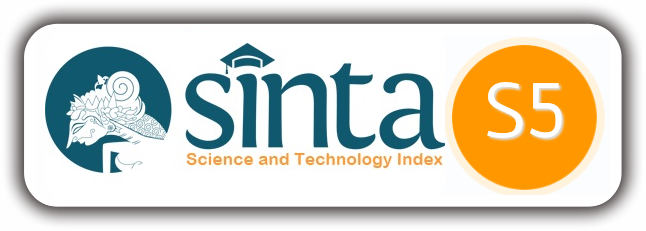ANALISIS FAKTOR PENGGUNAAN APLIKASI INVENTORY CONTROL SYSTEM (ICS) DENGAN MODEL PENERIMAAN TEKNOLOGI YANG DIMODIFIKASI PADA RIA BUSANA CHAIN STORE
Angelina Corahta br. Sinulingga(1*), Didi Achjari(2)
(1) Universitas Gadjah Mada, Yogyakarta
(2) Departemen Akuntansi, Fakultas Ekonomika dan Bisnis, Universitas Gadjah Mada, Yogyakarta
(*) Corresponding Author
Abstract
Penelitian ini bertujuan untuk menguji faktor-faktor yang memengaruhi pengguna dalam menggunakan aplikasi Inventory Control System (ICS), sebuah aplikasi yang wajib digunakan oleh pegawai Ria Busana Chain Store, berdasarkan perceived usefulness dan perceived ease of use yang dipengaruhi oleh management support. Penelitian ini menggunakan Technology Acceptance Model. Penelitian ini merupakan penelitian kuantitatif dan penyebaran kuesioner dilakukan pada seluruh pengguna aplikasi ICS. Hasil kuisioner dianalisis menggunakan Partial Least Square (PLS). Variabel independen yang digunakan dalam penelitian ini ialah management support, perceived usefulness, perceived ease of use, dan attitude toward reusing, sedangkan variabel dependennya adalah information system continuance intention. Hasil analisis terhadap 84 kuesioner yang diterima, menunjukkan bahwa management support dan perceived usefulness memiliki pengaruh terhadap information system continuance intention. Sedangkan perceived ease of use melalui attitude toward reusing tidak memiliki pengaruh terhadap intention. Di antara variabel-variabel tersebut, perceived usefulness merupakan faktor paling kuat yang mempengaruhi niat penggunaan ICS secara berkelanjutan pada pegawai Ria Busana Chain Store.
Keywords
Full Text:
PDFReferences
Abdul-Gader, A. H. 1992. “End User Computing Success Factors: Further Evidence from A Developing Nation”. Journal of End User Computing, p. 4-13. Ajzen, I. dan Fishbein, M. 1980. Understanding Attitudes and Predicting Social Behavior. Prentice Hall: Englewood-Cliffs, NJ. Bhattacherjee, Anol. 2001. “Understanding Information Systems Continuance: An Expectation Confirmation Model”. MIS Quarterly Vol. 25, pp. 351-370. Brown, SA., AP. Massey, MM. Montoya-Weiss, dan JR. Burkman. 2002. “Do I Really Have to? User Acceptance of Mandated Technology”. European Journal Information Systems, 11, p. 283-295. Chau, P.Y.K. 1996. “An Empirical Assessment of A Modified Technology Acceptance Model”. Journal of Management Information Systems (13:2), p. 185-204. Cooper, D.R., dan Schindler, P. 2016. Business Research Methods 12th Edition. New York: McGraw Hill. Davis, F.D. 1986. “Technology Acceptance Model for Empirically Testing New End-User Information Systems Theory and Results”. Unpublished Doctoral Dissertation: MIT. Davis, F. 1989. “Perceived Usefulness, Perceived Ease of Use, and User Acceptance of Information Technology”. MIS Quarterly 13(3) p. 319-340. Delone, W. H. 1988. “Determinants of Success for Computer Usage in Small Firms”. MIS Quarterly (12:1), Maret. P. 51-61. Ghozali, Imam. 2006. Aplikasi Analisis Multivariate dengan Program SPSS. Edisi Kedua. Yogyakarta: Penerbit Universitas Diponegoro. Hair et al. 1998. Multivariate Data Analysis, Fifth Edition. New Jersey: Prentice Hall. Hartono, Jogiyanto. 2008. Sistem Informasi Keperilakuan. Yogyakarta: Penerbit Andi. Hartono, Jogiyanto dan Willy Abdillah. 2015. Partial Least Square (PLS): Alternatif Structural Equation Modeling (SEM) dalam Penelitian Bisnis. Yogyakarta: Penerbit Andi. Igbaria, M., dan Iivari, J. 1995. “The Effects of Self-Efficacy on Computer Usage”. Omega (23:6), p. 587-605. Igbaria, M., Zinatelli, N., Cragg, P., dan Cavaye, A.L.M. 1997. “Personal Computing Acceptance Factors in Small Firms: A Structural Equation Model”. MIS Quarterly (21:3), p. 279-305. Leonard-Barton D. 1988. “Implementation Characteristics of Organizational Innovations”. Communications Research 15 (5), p. 603-631. Markus, ML. 1983. “Power, Politics, and MISS Implementation”. Communication of the ACM 26 (6), p. 430-444. Mathieson, K. 1991. “Predicting User Intentions: Comparing the Technology Acceptance Model with the Theory of Planned Behavior”. Information Systems Research 2 (3), p. 173-191. Melone N.P. 1990. “A Theoritical Assessment of the User-satisfaction Construct in Information Systems Reseacrh”. Management Science (36:1), p. 76-91. Ragu-Nathan, Bhanu S., Charles H. Apigian, T.S. Ragu-Nathan, Qiang Tu. 2004. “A path Analytic Study of the Effect of Top Management Support for Information Systems Performance”. Omega (32), p. 459-471. Ram, S., dan Jung H.S. 1991. “‘Forced’ Adoption of Innovations in Organizations: Consequences and Implications”. Journal of Product and Innovation Management 8, p. 117-126. Sekaran, Uma and Roger, Bougie. 2010. Research Methods for Business: A Skill Building Approach, 5th ed. New York: John Wiley & Sons Sohal, A.S., S. Moss, L. Ng. 2001. “Comparing IT Success in Manufacturing and Service Industries”. International Journal of Operations and Production Management 21(1,2) p. 30-45. Sugiyono. 2008. Metode Penelitian Bisnis. Bandung: Alfabeta. Sun, H., dan Zhang, P. 2003. “A New Perspective to Analyze User Technology Acceptance”. Working Paper, Syracuse University. Teo, Thompson S.H., dan James S.K. ANg. 1997. “Critical Success Factors in the Alignment of IS Plans witg Business Plans”. International Journal Information Management 19, p. 173-189. Venkatesh, V., dan Goyal, S. 2010. “Expectation Disconformation and Technology Adoption: Polynomial Modeling and Response Surface Analysis”. MIS Quarterly, Vol. 34, pp. 281-303. Yap, C. S., Soh, P. P., dan Raman K.S. 1992. “Information Systems Success Factors in Small Business”. Omega (20: 5/6), p. 597-609. Zuboff, S. 1998. In the Age of Smart Machine. Basic Books: New York.
Article Metrics
Refbacks
- There are currently no refbacks.
This work is licensed under a Creative Commons Attribution 4.0 International License.
______________________________________________________________________________________________________
2302 - 1500


_logo2.png)





